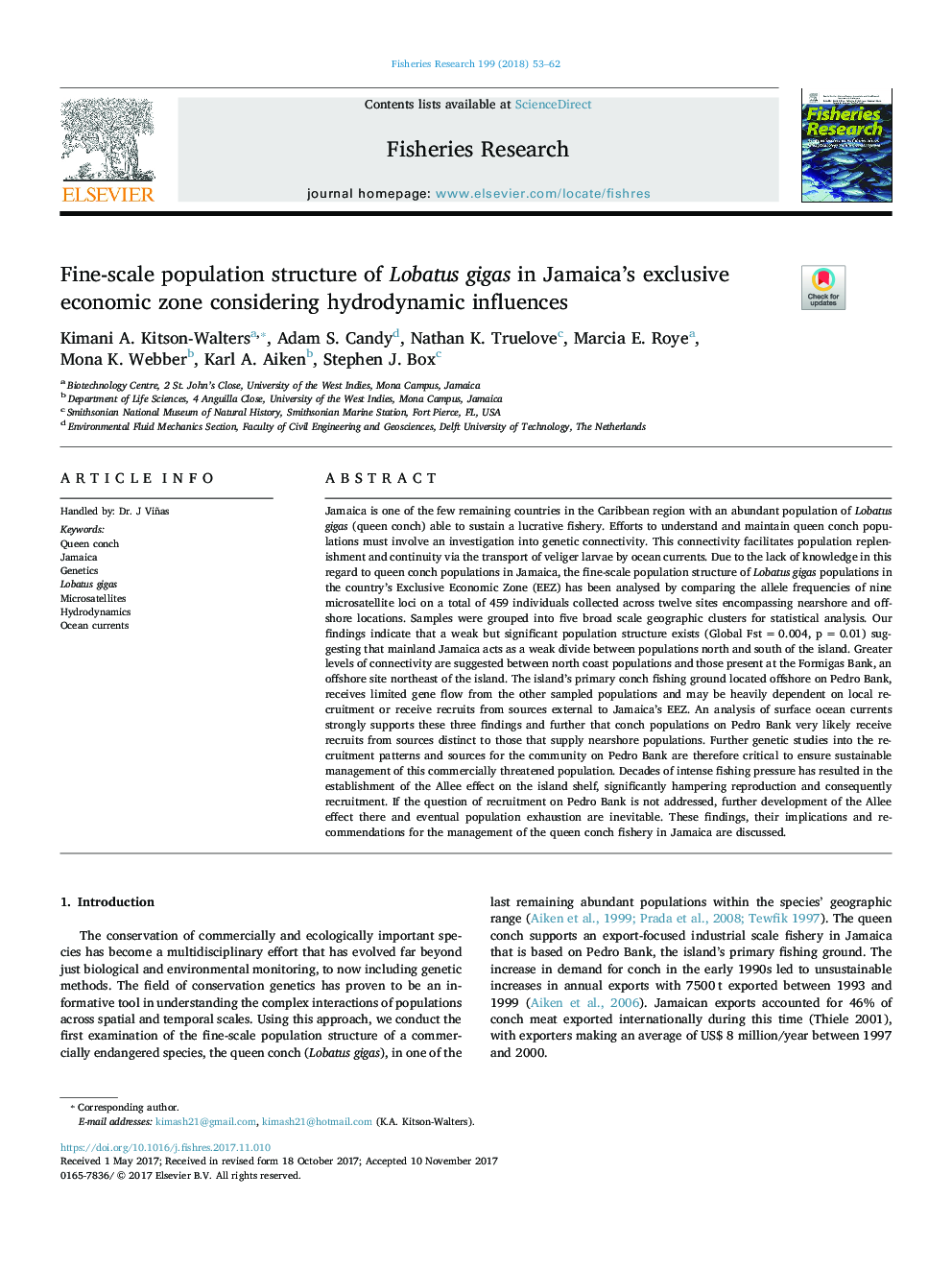| کد مقاله | کد نشریه | سال انتشار | مقاله انگلیسی | نسخه تمام متن |
|---|---|---|---|---|
| 8885536 | 1626771 | 2018 | 10 صفحه PDF | دانلود رایگان |
عنوان انگلیسی مقاله ISI
Fine-scale population structure of Lobatus gigas in Jamaica's exclusive economic zone considering hydrodynamic influences
ترجمه فارسی عنوان
ساختار جمعیتی در مقیاس جمعیت لوباتوس در منطقه منحصر به فرد اقتصادی جامائیکا با توجه به تأثیرات
دانلود مقاله + سفارش ترجمه
دانلود مقاله ISI انگلیسی
رایگان برای ایرانیان
کلمات کلیدی
ملکه کوه، جامائیکا، ژنتیک، گیاهان لوباتوس، میکروسستاتیت، هیدرودینامیک، جریان های اقیانوسی،
موضوعات مرتبط
علوم زیستی و بیوفناوری
علوم کشاورزی و بیولوژیک
علوم آبزیان
چکیده انگلیسی
Jamaica is one of the few remaining countries in the Caribbean region with an abundant population of Lobatus gigas (queen conch) able to sustain a lucrative fishery. Efforts to understand and maintain queen conch populations must involve an investigation into genetic connectivity. This connectivity facilitates population replenishment and continuity via the transport of veliger larvae by ocean currents. Due to the lack of knowledge in this regard to queen conch populations in Jamaica, the fine-scale population structure of Lobatus gigas populations in the country's Exclusive Economic Zone (EEZ) has been analysed by comparing the allele frequencies of nine microsatellite loci on a total of 459 individuals collected across twelve sites encompassing nearshore and offshore locations. Samples were grouped into five broad scale geographic clusters for statistical analysis. Our findings indicate that a weak but significant population structure exists (Global Fstâ¯=â¯0.004, pâ¯=â¯0.01) suggesting that mainland Jamaica acts as a weak divide between populations north and south of the island. Greater levels of connectivity are suggested between north coast populations and those present at the Formigas Bank, an offshore site northeast of the island. The island's primary conch fishing ground located offshore on Pedro Bank, receives limited gene flow from the other sampled populations and may be heavily dependent on local recruitment or receive recruits from sources external to Jamaica's EEZ. An analysis of surface ocean currents strongly supports these three findings and further that conch populations on Pedro Bank very likely receive recruits from sources distinct to those that supply nearshore populations. Further genetic studies into the recruitment patterns and sources for the community on Pedro Bank are therefore critical to ensure sustainable management of this commercially threatened population. Decades of intense fishing pressure has resulted in the establishment of the Allee effect on the island shelf, significantly hampering reproduction and consequently recruitment. If the question of recruitment on Pedro Bank is not addressed, further development of the Allee effect there and eventual population exhaustion are inevitable. These findings, their implications and recommendations for the management of the queen conch fishery in Jamaica are discussed.
ناشر
Database: Elsevier - ScienceDirect (ساینس دایرکت)
Journal: Fisheries Research - Volume 199, March 2018, Pages 53-62
Journal: Fisheries Research - Volume 199, March 2018, Pages 53-62
نویسندگان
Kimani A. Kitson-Walters, Adam S. Candy, Nathan K. Truelove, Marcia E. Roye, Mona K. Webber, Karl A. Aiken, Stephen J. Box,
